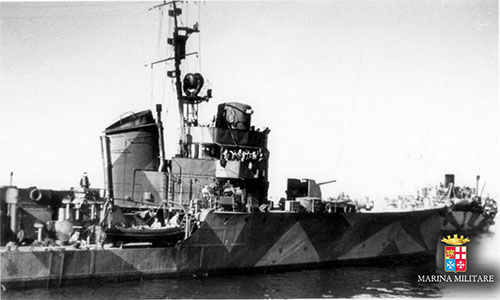The 12 February of the 1942, the torpedo boat Circe, under the command of Lieutenant Captain Stefanino Palmas, was carrying out an escort operation in the Gulf of Taranto, when at 20.20 he received the order to start a patrol in the area between Crotone and Punta Alice.
In this stretch of sea, the Italian ship Lucania, engaged in a humanitarian operation, had been torpedoed and sunk by the British submarine Una. The tragic event, in correlation with other events, suggested that there was a consistent presence of British submarines off the Calabrian coast.
Commander Palmas began the anti-submarine fighter and after a few hours of patrolling, at 03.02 on 13 February, he spotted a British submarine on the surface, thirty miles from Crotone. It was the Tempest (N86) under the command of William Alexander Cavaye, who, in turn, had taken over the position of Circe. Shortly thereafter, two experienced commanders would face each other in a clash where precision and speed would be critical to victory.
The commander of the Tempest he decided to attack abruptly with the two external torpedo launchers, rejecting the hypothesis of immersion, a choice that proved fatal; the torpedo boat Circe in fact, he had reversed his course and was heading boldly towards him. It was only then that Cavaye gave the diving order and the Tempest quickly disappeared between the waters.
Thanks to a careful use of the ecogoniometer, the Circe he identified the submarine in a few minutes and at 03.32 Palmas ordered the first launch of depth bombs. The Tempest he was hit! The damage was such that it became ungovernable, the lights and all the instruments on board were put out of use. The agitation and the frenzy of the men of the crew were replaced by the dutiful silence: a slight jolt could be fatal, the ecogoniometer of the Circe he could have detected it by revealing, in this way, the new position of the submarine.
 At that moment Commander Palmas' control over the enemy crew became total. He could have launched a second attack immediately but given the supremacy achieved he preferred to wait for the dawn; a decision dictated by the impossibility of using depth bombs for more than four launches and by the rough sea that would not have allowed them to be carried out with precision. For a few hours the submarine's crew believed that the Circe he would no longer be able to locate them but this hope suddenly vanished when, at 07.16, Palmas gave the order to attack.
At that moment Commander Palmas' control over the enemy crew became total. He could have launched a second attack immediately but given the supremacy achieved he preferred to wait for the dawn; a decision dictated by the impossibility of using depth bombs for more than four launches and by the rough sea that would not have allowed them to be carried out with precision. For a few hours the submarine's crew believed that the Circe he would no longer be able to locate them but this hope suddenly vanished when, at 07.16, Palmas gave the order to attack.
The submarine was hit again, the naphtha and the air bubbles were outcropping, so without any hesitation, Palmas proceeded with the third launch of depth bombs. It was at that point that al Tempest nothing remained but to re-emerge, using the still functioning stern rudders. In the meantime the chloride gas had already begun to spread inside it.
Those moments were told by the commander Palmas: "At 09.45 hours I'm moving away from the area of air bubbles, when stern to the left at about 1000 meters I see the submarine emerge immediately to the left to put me on a parallel course, I give the alarm , I immediately send cannons and machine-guns to the tappet ".
It was then that Palmas sighted two men in the turret, who seemed to be preparing to use the cannon. The Circe he was forced to open fire, first with the machine gun, then with nine cannon shots from 100 mm. Only then the men of the Tempest they accepted defeat and began to throw themselves into the sea, unfortunately many of them, including Cavaye himself, had lost their lives. After recovering the 23 shipwrecked crew, including three officers, Palmas tried to tow the captured submarine but after a few moments it began to sink and in a few minutes the bow, now in a vertical position, was submerged. "6 hours and 31 minutes of hunting are crowned with success!".
In February of the 1942, after only two months from its entry into service, the 1327 tons of the "ultra-modern" Tempest they lay on the seabed, his participation in the war was cut short by the sagacity of the commander Stefanino Palmas and his crew. Due to its relevance, the sinking was mentioned in the war bulletin no. 631.
 (photo: Navy / Imperial War Museum)
(photo: Navy / Imperial War Museum)












